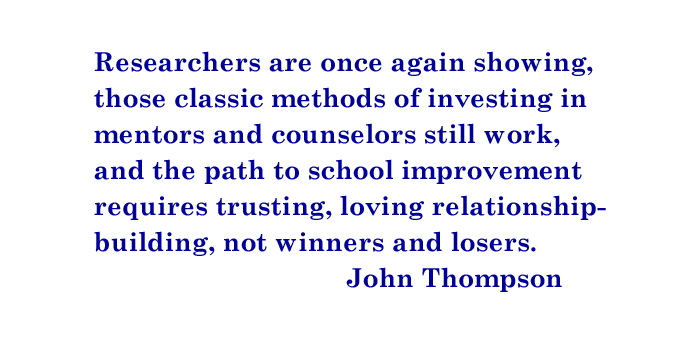By John Thompson.
The good news is that graduation rates are improving across the nation (see this announcement from a few days ago.) The best news is that social science points the way to even greater progress.
Ironically, corporate school reformers, who have focused obsessively on improving student “achievement” as measured by test scores, are now shifting attention to graduation rates and away from their failure to improve teaching and learning. Although this pivot is public relations-driven, designed to distract from the lack of gains produced by their competition-driven mandates, educators should welcome it and offer to work collaboratively with anyone who will help improve children’s life prospects.
We must also remind the non-education press that the fundamental reason for test-driven reform, supposedly, was that accountability hawks demanded “output-driven” mandates to replace “input-driven” school improvement. The effort to raise graduation rates is a classic input-driven reform, and it still works.
As Jack Jennings reminds us, the old-fashioned input-driven policies that preceded standards and testing were not perfect. The old progressive efforts to build student supports became underfunded, but they produced positive results that are greater than the expensive accountability-driven pedagogies that were supposedly more tough-minded. Now, as University of Chicago researchers are once again showing, those classic methods of investing in mentors and counselors still work, and the path to school improvement requires trusting, loving relationship-building, not winners and losers.
To further prepare students for a meaningful and healthy life, we must heed the findings of Don’t Quit on Me, by The Center for Promise at America’s Promise Alliance. It begins with the seemingly unchallengeable scientific evidence that, “Social relationships are a fundamental need for all humans, built into our biological, neurological and psychological architecture.” The study explains why schools must ramp up the battle against the legacies of “adverse childhood experiences (ACEs), toxic stress, structural barriers such as poverty and institutionalized bias.”
The next era of school improvement must heed a first rule of classroom teachers, listen to the kids and they will teach us how to teach them. The Center for Promise’s Don’t Quit on Me features interviews with students who tell the same stories that I heard throughout my career in the inner city. It is consistent with the way my students would be on track in their early years until they lost the parent who raised them or attended too many family funerals. During their mourning, children would fall off the academic conveyor belt. There was no institutionalized method for helping them get back on track.
The study features statements such as this:
At eight years old, I had a good life … till my father passed away. Then my mother became depressed… I think it impacted me a lot because he died by overdose in front of us so I think it impacted us, me and my brother a lot. Because I think sometime my mama would blame us for that. So yeah it impacted me a lot…
I was just struggling with my mother the whole time. I mean by the time she got me out of foster care, my ma just practically told me I ain’t need her. You know my mother was struggling so I couldn’t really focus at school. You know there was so much in my head going on that I fell down…
The Center for Promise graphically displays a concise summary of our troubled students’ real priorities: Family, Friends, Love, and Trust. The next most cited concerns were: Care, Connections, Bonds, Honesty, Partnership, and Respect. Reformers who believe that punitive measures are essential should note that the only negative issues mentioned were hate and disloyalty.
Obviously, the reality our kids face doesn’t lend itself to the cheap, quick, and simplistic shortcut of test-driven reform. In personal conversations, reformers often tell me that they are disenchanted with high stakes testing, but it is too difficult to persuade voters to fund more counselors, mentors, and the extra services needed to raise graduation rates. By now, such an argument is the intellectual equivalent of “we lose money on every sale, but we make it up on volume.”
Real solutions require the financing, planning, aligning and coordinating of student supports. That task seemed too daunting for reformers to tackle. But, as recent improvements in graduation rates show, in many ways support-driven policies are more doable. We simply don’t know how to build quantitative systems for distributing rewards and punishments without compromising the integrity and humanity of schools. But, we humans do know how to love each other, how to mentor, how to create bonds across generations, and to give kids a timely boost when they struggle. In a future post, I will tackle some of policy complexities and what it will take to scale up humane programs for helping students graduate and succeed in post-school life.





mranderson
On target with the quote of the day by Joe Madison, “Education is the currency of the 21st century.”